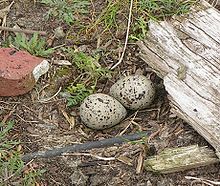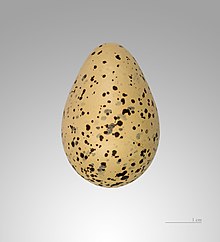Ringed plover
| Ringed plover | ||||||||||
|---|---|---|---|---|---|---|---|---|---|---|

Ringed Plover ( Charadrius hiaticula ) |
||||||||||
| Systematics | ||||||||||
|
||||||||||
| Scientific name | ||||||||||
| Charadrius hiaticula | ||||||||||
| Linnaeus , 1758 |
The ringed plover ( Charadrius hiaticula ) is a species of bird from the family of Plover (Charadriidae). It is a breeding bird in northern Europe, Asia, South and North America. In Central Europe it breeds in the coastal area of the North and Baltic Seas. Because of the large number of ringed plovers that gather on the spring migration in the Wadden Sea off the Schleswig-Holstein coast, this region is considered the most important resting place of this species. Inland, it is particularly popular in April and May and from August to October.
There are three only slightly differentiated subspecies, which differ mainly in their moulting rhythm.
description
The ringed plover looks very similar to its relative, the little ringed plover . The ringed plover is a little bigger and stronger. A fully grown ringed plover is 18 to 20 cm tall and weighs 40 to 80 g. The wingspan is 40 to 55 cm. The ringed plover can live up to 11 years. Exceptionally, birds of this species also get significantly older, as re-discoveries of ringed animals show: A ringed plover marked on the British Isles reached an age of 20 years and nine months, an animal marked in Germany 14 years and eight months.
Its back is gray-brown and its underside is colored white. The short beak is dark in front and yellow in the back. Its legs are yellowish and the eyes are black. The front part of the head is drawn in black and white. In addition, the ringed plover has a wide black collar. Unlike the little ringed plover, the ringed plover has a white wing band that can be clearly seen in flight. Males and females have the same coloration.
habitat
The distribution area of the ringed plover stretches from northeast Canada over Greenland, Iceland and the tundra zones, the boreal zones and the temperate climates of Eurasia to the west coast of Arctic North America. The nominate form Charadrius hiaticula hiaticula occurs from southern Scandinavia via Iceland and Greenland to northeastern Canada. The subspecies Charadrius hiaticula tundrae is distributed from northern Scandinavia to Siberia. The subspecies Charadrius hiaticula psammodroma breeds in northeastern Canada, Greenland, Iceland, the Faroe Islands and Jan Mayen . It winters in West and South Africa.
The ringed plover lives mainly on the shallow, vegetation- free coasts of Central and Northern Europe . He is rarely a guest on inland waters . Ringed plovers overwinter on the coasts of western and southern Europe, on the African continent south of the Sahara and in south-western Asia. In addition to the Wadden Sea of the North Sea, important European resting and wintering areas include the Coto de Doñana , the coast off Isla Cristina , the mouths of the Tejo and Sado rivers , the Ria de Aveiro , the Bay of Guissény , the Île de Ré and the Gulf of Morbihan . Important African wintering spots are Lake Turkana and the Banc d'Arguin .
nutrition
The ringed plover feeds on worms , snails , crustaceans , spiders , insects and their larvae . Similar to most plovers, feeding occurs in a rhythm that consists of a quick run, an abrupt stop and a peck. Very often a foot trill occurs , in which the bird steps on the spot in rapid succession. This behavior presumably serves to lure prey to the surface.
Reproduction
Ringed plovers are distinctly territorial breeding birds and are similar to the little ringed plovers. From March the birds begin to move into their breeding grounds . Ringed plovers have a very extended breeding period. Egg-laying can occur as early as March. Most clutches are laid in May. Ringed plovers often raise two broods per year. In particularly favorable circumstances, it can happen that they successfully raise a third clutch.
Ringed plovers usually breed on the seashore on open gravel, sand and dry mud flats. Far seldom do they build their nests on the banks of inland waterways or on wastelands. In Scandinavia, however, ringed plovers also breed in the high-lying dwarf tundra.
The nest is a hollow on the ground lined with tiny stones , which the female scratches. It is laid out with small stones, parts of plants, shells and small pieces of floating debris. Occasionally it is just a simple, unpadded depression in the floor. It is often found near plant clusters and is often also built under one. The female lays four sand-colored, dark-spotted eggs , which are warmed by both partners for 23 to 25 days until the chicks hatch.
The chicks leave the nest shortly after hatching. At this point in time they find their food independently. However, they are guarded and flocked by the adult birds. A grave danger, parents lure through a behavior known as enticing , the animals in a different direction and try to protect their young. After three or four weeks, the young birds are fully fledged. They are sexually mature within the first year of life.
Duration
The European breeding population is estimated at 120,000 to 220,000 breeding pairs at the beginning of the 21st century. Countries with more than 10,000 breeding pairs include Greenland, Iceland, Norway, Russia and Sweden. A total of around 1,800 to 2,600 breeding pairs occur on the coast and inland plains of Belgium, the Netherlands, Germany and Poland.
The ringed plover is considered critically endangered in Germany and is listed in category 1 of the Red List. Ringed plovers are also considered to be one of the species in which global warming will have a particularly pronounced effect on distribution. A research team that, on behalf of the British environmental authority and the Royal Society for the Protection of Birds (RSPB), examined the future development of the distribution of European breeding birds on the basis of climate models, assumes that by the end of the 21st century, two thirds of the current distribution area no longer offer suitable habitats for this species. This applies, among other things, to the breeding areas in Poland, the Baltic states, the southern part of Great Britain and Fenno Scandinavia as well as the coast of France and the North Sea. In northern Europe, due to global warming, the Franz-Josef-Land, among others, offer new opportunities for spreading. However, this area expansion in the north cannot compensate for the loss of area in the south.
supporting documents
literature
- Hans-Günther Bauer, Einhard Bezzel and Wolfgang Fiedler (eds.): The compendium of birds in Central Europe: Everything about biology, endangerment and protection. Volume 1: Nonpasseriformes - non-sparrow birds. Aula-Verlag Wiebelsheim, Wiesbaden 2005, ISBN 3-89104-647-2 .
- Einhard Bezzel: birds. BLV Verlagsgesellschaft, Munich 1996, ISBN 3-405-14736-0
- Simon Delany, Derek Scott, Tim Dodman, David Stroud (Eds.): An Atlas of Wader Populations in Africa and Western Eurasia. Wetlands International , Wageningen 2009, ISBN 978-90-5882-047-1 .
Web links
- Charadrius hiaticula in the endangered Red List species the IUCN 2008. Posted by: BirdLife International, 2008. Accessed January 31 of 2009.
- www.naturbildarchiv-guenter.de Picture story on biology and courtship (with parade march) of the ringed plover Charadrius hiaticula
- Videos, photos and sound recordings of Charadrius hiaticula in the Internet Bird Collection
- Age and gender characteristics (PDF; 3.9 MB) by J. Blasco-Zumeta and G.-M. Heinze (English)
- Ringed plover feathers
Individual evidence
- ↑ Delany et al., P. 199
- ↑ Foken, W .: From the ringing center, Jber. Inst. Vogelforsch. 3: 33-35, quoted from Hüppop, K. & O. Hüppop: Atlas for bird ringing on Helgoland, part 5, Vogelwarte 47 (2009) p. 214
- ↑ Bauer et al., P. 444
- ↑ Delany et al., P. 196
- ↑ Delany et al., P. 200 and p. 201
- ↑ a b Collin Harrison and Peter Castell: Field Guide Bird Nests, Eggs and Nestlings , HarperCollins Publisher, revised edition from 2002, ISBN 0-00-713039-2 , p. 136
- ↑ Bauer et al., P. 444
- ↑ Christoph Grüneberg, Hans-Günther Bauer, Heiko Haupt, Ommo Hüppop, Torsten Ryslavy, Peter Südbeck: Red List of Germany's Breeding Birds , 5 version . In: German Council for Bird Protection (Hrsg.): Reports on bird protection . tape 52 , November 30, 2015.
- ^ Brian Huntley, Rhys E. Green, Yvonne C. Collingham, Stephen G. Willis: A Climatic Atlas of European Breeding Birds , Durham University, The RSPB and Lynx Editions, Barcelona 2007, ISBN 978-84-96553-14-9 , P. 171






